Common garden weeds in the Yuba-Sutter area are usually non-native plants, but not necessarily classified as invasive weeds. To be classified as invasive, a weed must be shown to pose a serious threat to the survival of native species. Some weeds can pose a tremendous threat to your garden plants without actually posing much of a threat to native species, if the ecological niche they fill is a niche that exists mostly in gardens and that native plants wouldn't have thrived in anyway. This page lists plants that are common garden weeds but not classified as invasive species by the California Invasive Plant Council. All the plants listed on our invasive weeds page may also be common garden weeds, but to avoid redundancy, we will not reprint their names here.
Some people intentionally plant both common garden weeds and invasive weeds, due to the facts that weedy plants are easy to grow and some of them are pretty. It is a very bad idea to plant invasive weeds, because they are likely to kill off all your other plants, all your neighbors' plants, and all the plants in wildlife habitats for miles around. However, it is relatively acceptable to intentionally plant the common garden weeds listed below, because although they may still spread somewhat aggressively, they do not pose a major risk to wildlife habitats.
Annuals are generally weedier than perennials, which in turn are generally weedier than woody plants. The shorter a plant's lifespan is, the more rapidly it has to reproduce. The more rapidly a plant reproduces, the quicker it can take over an entire garden, killing all the other plants in sight. Fewer natives grow out of control than non-natives, because local ecosystems have evolved adaptations to keep natives in check. And certain plant families contain more weeds than others—in particular, the aster, mustard, carnation, goosefoot, pea, grass, and rose families contain significant numbers of plants that tend to be weedy in the Yuba-Sutter area.
 Various weeds poke up between the pavers of an untended patio in Marysville. The overwhelming majority of these common garden weeds are non-native. Photo by queerbychoice.
Various weeds poke up between the pavers of an untended patio in Marysville. The overwhelming majority of these common garden weeds are non-native. Photo by queerbychoice.
Weedy Annuals
Natives
Aster Family
 Rough cockleburr (Xanthium strumarium) in Beckwourth Riverfront Park Complex. Photo by queerbychoice.
Rough cockleburr (Xanthium strumarium) in Beckwourth Riverfront Park Complex. Photo by queerbychoice.
- sticktight (also called devil's beggartick)
- Canadian horseweed
- common sunflower (also called hairyleaf sunflower)
- rod wirelettuce (also called twiggy wreath plant)
- spiny cockleburr
- rough cockleburr
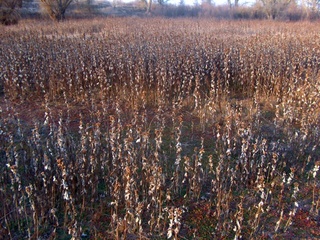 Rough cockleburr (Xanthium strumarium) has taken over a large area across the levees from Marysville High School. After it dies off each fall, the spiny seeds dry and harden, clinging painfully to the clothes or fur of any people or animals who try to walk through it. Photo by queerbychoice.
Rough cockleburr (Xanthium strumarium) has taken over a large area across the levees from Marysville High School. After it dies off each fall, the spiny seeds dry and harden, clinging painfully to the clothes or fur of any people or animals who try to walk through it. Photo by queerbychoice.
Other Plant Families
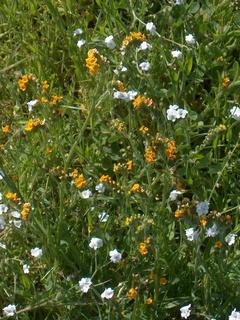 Coast fiddleneck (Amsinckia menziesii) and popcorn flowers (Plagiobothrys) on Table Mountain. Photo by queerbychoice.
Coast fiddleneck (Amsinckia menziesii) and popcorn flowers (Plagiobothrys) on Table Mountain. Photo by queerbychoice.
- littleleaf bentgrass
- mat amaranth (also called prostrate pigweed)
- Powell's amaranth
- coast fiddleneck
- red maids
- little bittercress
- willowherbs
- tufted lovegrass
- common bedstraw (also called goosegrass, stickywilly, or cleavers)
- hayfield tarweed
- Virginia pepperweed (also called wild peppergrass)
- sharpleaf groundcherry
- cutleaf groundcherry
- ram's horn
- sticky pearlwort (also called dwarf pearlwort)
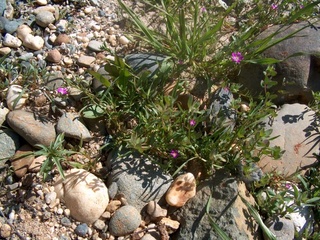 Red maids (Calandrinia ciliata) bloom among river rocks at Parks Bar. Photo by queerbychoice.
Red maids (Calandrinia ciliata) bloom among river rocks at Parks Bar. Photo by queerbychoice. 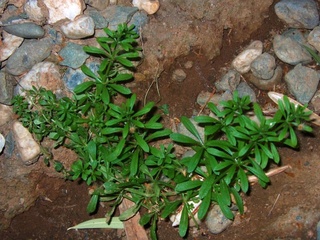 Common bedstraw (Galium aparine) in a garden in Marysville. Photo by queerbychoice.
Common bedstraw (Galium aparine) in a garden in Marysville. Photo by queerbychoice.
Non-Natives
Aster Family
- western sticktight (also called big devil's beggartick)
- dusky dogfennel
- common pineapple weed
- tropical horseweed (also called asthmaweed)
- annual fleabane
- common cudweed (also called fragrant everlasting)
- cretanweed
- narrowleaf cottonrose
- common pineapple weed
- old man of the spring (also called common groundsel)
- common sowthistle
Mustard Family
Carnation Family
- mouse-ear chickweed (also called sticky chickweed)
- pinkgrass (also called hairypink or windmill pink)
- fourleaf allseed
- windmill pink (also called common catchfly)
- corn spurry
- common chickweed
- Spanish cockle (also called cowherb or cow soapwort)
Goosefoot Family
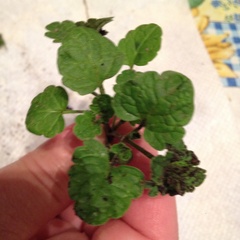 Lamb's quarters (Chenopodium album) in a garden in Marysville. Photo by queerbychoice.
Lamb's quarters (Chenopodium album) in a garden in Marysville. Photo by queerbychoice.
- lamb's quarters (also called white goosefoot)
- strawberry blite goosefoot
- leafy goosefoot
- nettleleaf goosefoot (also called sowbane)
- stinking goosefoot
- Jerusalem oak goosefoot (also called feather geranium)
- clammy goosefoot (also called small crumbweed)
Pea Family
- yellow pea (also called yellow vetchling)
- rough pea
- shamrock clover (also called suckling clover)
- clustered clover
- crimson clover
- knotted clover
- subterranean clover
- redtuft vetch (also called purple vetch)
- garden vetch (also called spring vetch or smaller common vetch)
- thickfruit vetch (also called winter vetch, woollypod vetch, or smooth vetch)
Grass Family
- little quakinggrass (also called little rattlesnake grass)
- poverty brome
- swamp pricklegrass
- hairy crabgrass
- jungle rice
- barnyardgrass (also called watergrass)
- nitgrass
- nitgrass
- bristly annual junegrass
- Darnel ryegrass
- fall panicgrass (also called smooth witchgrass)
- broomcorn millet
- littleseed canarygrass (also called Mediterranean canarygrass)
- hood canarygrass
- annual bluegrass
- Mediterranean hairgrass
- cereal ryegrass
- yellow bristlegrass
- green foxtail (also called green bristlegrass)
- sorghum
- common wheat
Other Plant Families
 Low amaranth (Amaranthus deflexus) in a garden in Marysville. Photo by queerbychoice.
Low amaranth (Amaranthus deflexus) in a garden in Marysville. Photo by queerbychoice.
- velvetleaf
- tumbleweed amaranth
- low amaranth
- redroot pigweed (also called green amaranth or rough pigweed)
- scarlet pimpernel
- bur chervil
- spotted spurge
- eyebane spurge (also called large spurge)
- variable flatsedge
- yellow flatsedge
- jimsonweed
- horsefly's eye
- petty spurge
- Lamarck's bedstraw
- yellow wall bedstraw (also called tiny bedstraw)
- wall bedstraw
- leafybract dwarf rush
- henbit deadnettle (also called giraffe head)
- bull mallow
- cheeseweed mallow
- green carpetweed (also called Indian chickweed)
- shellflower
- manyflower tobacco
- dwarf woodsorrel
- small woodsorrel
- dwarf woodsorrel
- redshank
- narrowleaf tomatillo
- Mexican groundcherry (also called Mexican tomatillo)
- spotted ladysthumb
- little hogweed (also called common purslane)
- yellow devil's claw
- cornfield buttercup
- Venus' needle (also called shepherd's needle]
- blue fieldmadder
- knotted hedgeparsley
- puncturevine
- lamb lettuce (also called cornsalad)
- corn speedwell
 Spotted ladysthumb (Polygonum persicaria) in a yard in Marysville. Photo by queerbychoice.
Spotted ladysthumb (Polygonum persicaria) in a yard in Marysville. Photo by queerbychoice.
Weedy Herbaceous Perennials
Natives
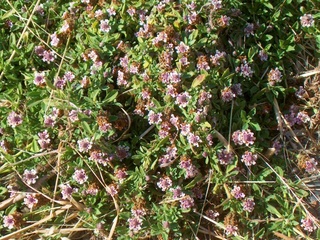 Turkey-tangle fogfruit (Phyla nodiflora) on a Marysville levee. Photo by queerbychoice.
Turkey-tangle fogfruit (Phyla nodiflora) on a Marysville levee. Photo by queerbychoice.
- common yarrow
- bentgrasses
- western ragweed
- yellow nutsedge (also called chufa flatsedge)
- purple everlasting (also called purple cudweed)
- turkey-tangle fogfruit (also called common lippia)
- common selfheal
- black-eyed Susan
- American black nightshade (also called smallflower nightshade or white nightshade)
- willowherbs
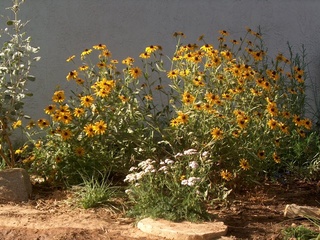 Common yarrow (Achillea millefolium) and black-eyed Susan (Rudbeckia hirta) in a garden in Marysville. Photo by queerbychoice.
Common yarrow (Achillea millefolium) and black-eyed Susan (Rudbeckia hirta) in a garden in Marysville. Photo by queerbychoice.
Non-Natives
Aster Family
Pea Family
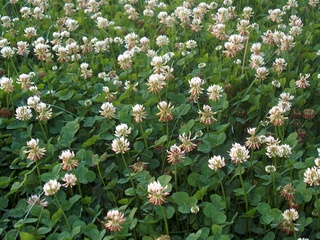 White clover (Trifolium repens) takes over an unmowed lawn in Marysville. Photo by queerbychoice.
White clover (Trifolium repens) takes over an unmowed lawn in Marysville. Photo by queerbychoice.
- black medick
- button clover (also called blackdisk medic)
- alfalfa
- strawberry clover
- red clover
- white clover
Grass Family
- water bentgrass
- green bentgrass
- broomsedge bluestem
- tall oatgrass
- common cultivated oats
- rescuegrass
- smooth brome
- roadside brome
- tall wheatgrass
- salt-tolerant tall wheatgrass
- meadow fescue
- English perennial ryegrass
- dallisgrass
- Vasey's grass
- Johnsongrass
- tall wheatgrass
Other Plant Families
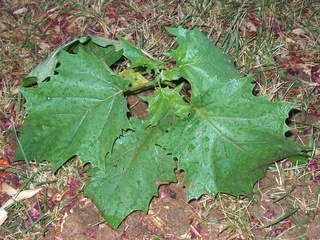 Jimsonweed (Datura stramonium) in a garden in Marysville. Photo by queerbychoice.
Jimsonweed (Datura stramonium) in a garden in Marysville. Photo by queerbychoice.
- common corncockle
- mignonette vine
- scurvy grass (also called early wintercress)
- mouse-ear chickweed
- nutgrass
- jimsonweed
- sweetwilliam
- Indian mock strawberry
- spring star flower
- swamp morning-glory
- sharpleaf cancerwort (also called sharpleaf fluellin)
- shortleaf spikesedge
- English peppergrass (also called cow cress or field pepperweed)
- common dwarf mallow
- spearmint
- Carolina bristlemallow
- redsepal evening primrose
- common plantain
- common dooryard knotweed (also called oval-leaf knotweed)
- prostrate knotweed
- spinyfruit buttercup (also called pricklefruit buttercup)
- wild radish (also called painted charlock or jointed charlock)
- fiddle dock
- small burnet
- bog bulrush
- bladder campion
- Carolina horsenettle
- red sandspurry (also called ruby sandspurry or purple sandspurry)
- moth mullein
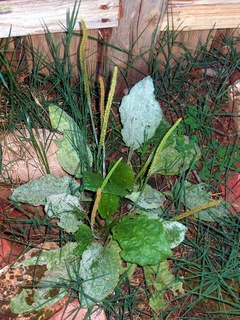 Common plantain (Plantago major) in an untended front yard in Marysville. Photo by queerbychoice.
Common plantain (Plantago major) in an untended front yard in Marysville. Photo by queerbychoice. 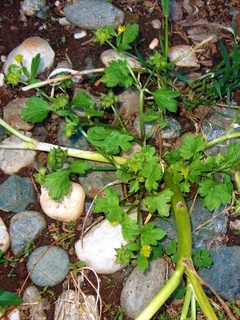 Spinyfruit buttercup (Ranunculus muricatus) in an untended front yard in Marysville. Photo by queerbychoice.
Spinyfruit buttercup (Ranunculus muricatus) in an untended front yard in Marysville. Photo by queerbychoice.
Weedy Woody Plants
Natives
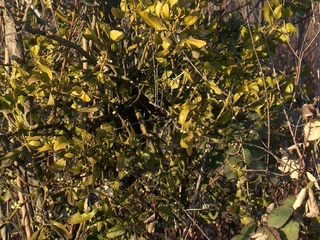 Pacific mistletoe (Phoradendron serotinum) parasitizes a shrub in Marysville. The chartreuse leaves and pale, greenish berries are the mistletoe. Photo by queerbychoice.
Pacific mistletoe (Phoradendron serotinum) parasitizes a shrub in Marysville. The chartreuse leaves and pale, greenish berries are the mistletoe. Photo by queerbychoice.
Non-Natives
Rose Family
- sweet almond tree
- dog rose
- eglantine rose
- sweet briar rose
- cutleaf blackberry
- elmleaf blackberry vine
Nightshade Family
Other Families
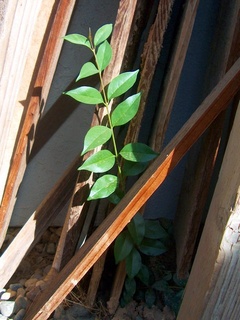 Glossy privet (Ligustrum lucidum) volunteers between loose boards at a house in Marysville. Photo by queerbychoice.
Glossy privet (Ligustrum lucidum) volunteers between loose boards at a house in Marysville. Photo by queerbychoice.
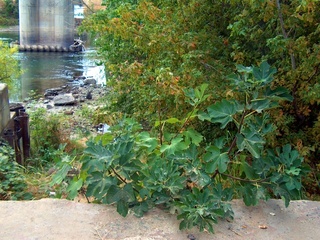 White mulberry (Morus alba) at Beckwourth Riverfront Park Complex in Marysville. Photo by queerbychoice.
White mulberry (Morus alba) at Beckwourth Riverfront Park Complex in Marysville. Photo by queerbychoice.


